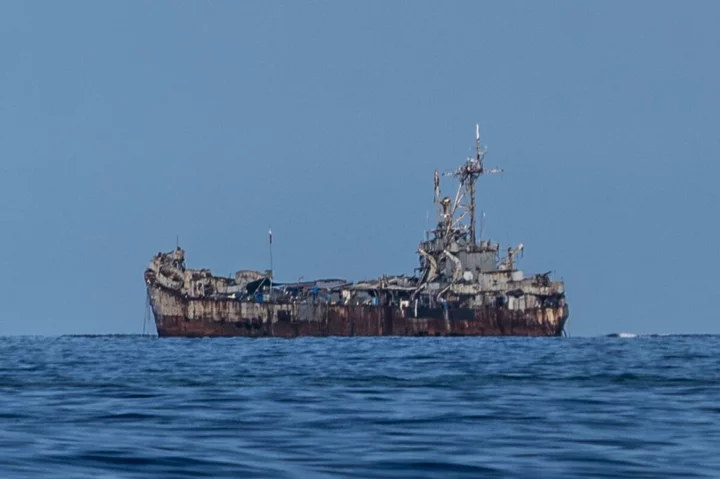As sailors scrambled to unload provisions from two small boats for troops on a grounded ship in the South China Sea, a US Navy aircraft flew overhead while three Japanese-built Philippine coast guard vessels kept watch.
They in turn were monitored by a flotilla of Chinese coast guard ships and other vessels that had spent the past few hours trying to obstruct the Philippine vessels from reaching their destination, including firing a water cannon.
The scene was the climax of the latest mission to resupply the BRP Sierra Madre, a decaying World War II-era vessel that Manila intentionally grounded on Second Thomas Shoal in 1999 in response to China’s occupation of Mischief Reef four years earlier. It’s the Philippines’ sole outpost in the shoal designed to establish its sovereignty in the fishing-rich waters.
The successful Nov. 10 mission was a display of the trilateral partnership between the Philippines, the US and Japan that is challenging Beijing’s efforts to control the disputed area. With Washington renewing its security guarantees for Manila, this remote reef has become a key flashpoint for US-China competition in the region, potentially rivaling the long-running friction over Taiwan.
The Philippine convoy last week hosted reporters from local and international media, including Bloomberg News, as part of Manila’s efforts to publicize China’s tactics. The mission came just days before US President Joe Biden and Chinese leader Xi Jinping are scheduled to meet in San Francisco in an effort to mend ties. Earlier this month, the US and China held their first talks focused solely on maritime issues since September 2019.
Over the years, Philippine officials have become increasingly worried about the degradation of the Sierra Madre. Rust and the elements have left gaping holes in the hull and could render the vessel uninhabitable if left unattended. China has steadfastly opposed the Philippines’ efforts to repair the Sierra Madre and has repeatedly urged Manila to tow it away.
“The deterioration is faster than the supply that we do,” Philippine Defense Senior Undersecretary Ireneo Espino said in September.
In the latest operation, the Philippines said it detected a total of 38 Chinese ships during the voyage, including fishing trawlers and a hospital vessel. Manila had five — the three coast guard ships built by Japan and two supply boats chartered by the military.
The mission began at around 9 a.m. on Thursday as two Philippine coast guard ships, with journalists on board, began escorting the supply boats on the day-long voyage to Second Thomas Shoal.
As one of the coast guard vessels, the BRP Sindangan, moved closer to the shoal, a speeding ship from China’s coast guard sailed in close proximity and abruptly cut across its path. Minutes later, the Sindangan was blocked when it was corralled by four Chinese vessels — two from the coast guard and two fishing trawlers.
“Even if they triple the number of Chinese vessels that they are going to deploy, the Philippine coast guard will not be deterred in carrying out the resupply operation,” coast guard spokesperson Commodore Jay Tarriela told reporters on Saturday in Manila. “We are still going to carry out this dangerous mission despite our limited number of vessels.”
On a previous resupply mission on Oct. 22, Chinese and Philippine vessels collided on two separate occasions. The damage to the Philippine supply boat was so bad that a replacement was used in Friday’s operation, the government said.
This time, the Philippine coast guard added a larger patrol vessel to the group, the Japan-built BRP Melchora Aquino — named after a Filipina hero known as the mother of the Philippine revolution. As the Melchora Aquino sailed toward Second Thomas Shoal, a China coast guard ship blasted a furious message to it.
“You must stop your illegal operation immediately. If you continue to disregard our warning, we will take necessary measures and you will take full responsibility for the consequences resulting therein.”
Throughout the journey, the Sindangan radioed to the Chinese vessels: “This is Philippine Coast Guard vessel BRP Sindangan conducting a routine maritime patrol within the Philippine exclusive economic zone. We are proceeding to our planned route. Leave immediately. Stay clear from our passage.”
China, which has made sweeping territorial claims over the South China Sea, on Friday said the Philippines “gravely violated China’s sovereignty” and Manila’s moves to repair and reinforce the stranded ship contravened international law.
“China will continue to take necessary measures in accordance with law to firmly safeguard our territorial sovereignty and maritime rights and interests,” Chinese Foreign Ministry Spokesperson Wang Wenbin said in a regular briefing.
The Philippines said a Chinese coast guard vessel fired a water cannon at one of its supply boats, forcing Manila’s embassy in Beijing to file a complaint with China’s foreign ministry on Friday.
Washington came to Manila’s defense, saying it stands shoulder-to-shoulder with the Philippines “in the face of China’s repeated harassment in the South China Sea.” After last month’s collision, President Biden warned that an attack on a Philippine public vessel in the South China Sea would trigger Washington’s defense commitments.
During a visit to Manila early this month, Japanese Prime Minister Fumio Kishida agreed with Philippine President Ferdinand Marcos Jr. to work on a trilateral cooperation with the US in the South China Sea.
Philippine efforts to publicize Chinese maritime incursions have won other countries’ support and caused “some damage” to Beijing’s reputation, said Carl Thayer, emeritus professor at the University of New South Wales in Australia. He said China could deploy “even more coast guard ships and maritime militia vessels” to act aggressively against the Philippines’ future resupply efforts.
“The scene is being set for a serious test of wills and an incident leading to physical damage and injury and possibly loss of life,” Thayer said.
--With assistance from Philip J. Heijmans and Kevin Dharmawan.

